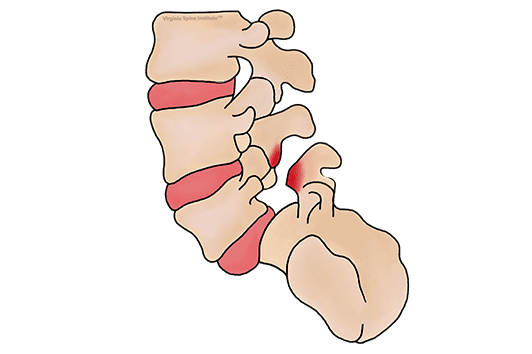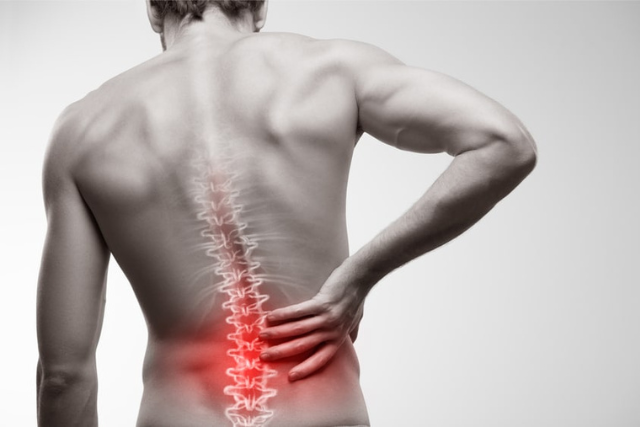Spondylolysis
Understanding the Symptoms, Causes & Treatments of Spondylolysis
Reviewed by: Dr. Christopher Good, Dr. Colin Haines, Dr. Ehsan Jazini
What is Spondylolysis?
Spondylolysis is a stress fracture of the pars interarticularis bone found on the posterior aspect of the spine. The pars interarticularis is the weakest part of the spine, especially in younger patients whose bones are still maturing. As seen in the image below, the red line marks the fracture line through this portion of the bone. When this fracture occurs, the vertebral body can slip forward otherwise known as an Isthmic Spondylolisthesis. This can be caused by traumatic impact from repetitive hyperextension of the spine from a sport like gymnastics, car accidents, a fall, or degenerative/genetic changes to the bone to name a few. Treatment is often aimed toward symptom management and surgical intervention will only be recommended if this causes severe nerve compression, intractable pain, or progressive neurologic damage.


Symptoms of Spondylolysis
The most common presenting symptom of a stress fracture in the pars interarticularis is back pain, muscle spasms, or stiffness in the low back. Your symptoms can range from mild to severe depending on the severity of the fracture or instability in the spine. In some cases, you may have symptoms of radiculopathy. These include pain, numbness, weakness, or tingling in the legs. If the fracture is severe enough causing a slippage, referred to as isthmic spondylolisthesis, there may be varying degrees of central stenosis which can be severely pinching the nerves potentially resulting in symptoms of cauda equina syndrome. If you experience loss of bowel or bladder control, urinary urgency, numbness or weakness in the legs, or numbness in the groin, contact your spinal expert immediately.
When to Seek Treatment for Spondylolysis
If you’re noticing symptoms associated with Spondylolysis and suspect a spinal issue, it’s crucial to consider consulting a board-certified spinal specialist. Reach out promptly to a certified spine surgeon for an accurate diagnosis and timely treatment. Early intervention can significantly improve your overall well-being and provide a broader range of treatment options, which may decrease as symptoms persist. The key to a successful and speedy recovery lies in addressing the root of the pain with your spine specialist as soon as symptoms arise.
While many people experience day-to-day back or neck pain, dismissing it as soreness, this may not be the case for everyone. If your pain persists for more than 10 days, it should be taken more seriously. Evaluate such prolonged pain with a spine surgeon to identify the root issue and determine the appropriate treatment. Additionally, be attentive to other signs related to back or neck pain that should not be ignored, including pain accompanied by fever, pain associated with loss of bladder control, and weakness/tingling/numbness in your arms or legs.
It’s important to note that these are general guidelines based on our expertise in spine care over the past three decades, recognizing that each patient’s symptoms may be unique.


Common Causes of Spondylolysis
In order to understand the cause of Spondylolysis, it is important to understand the anatomy of the spine. The spine consists of bone, discs, soft tissues, and nerves. There are 7 cervical, 12 thoracic, and 5 lumbar vertebral bodies stacked on top of one another. The disc lives between each bone and acts as a shock absorber of the spine. Behind the vertebral bodies and discs are the bones of the spinal column which bridge to form the spinal canal, which holds the spinal cord and adjacent nerves. The pars interarticularis is an important part of this structure. As this is a weak area of bone, especially in patients not yet skeletally mature, when extreme forces are applied a stress fracture can form. Repetitive hyper-extension or rotational forces, such as with gymnastics or baseball, are common mechanisms to develop a Spondylolysis. It is common in the younger population, estimated that 5-7% of adolescents have pars stress fractures. Fortunately, with proper rest and abdominal core strengthening this fracture normally heals within 6-8 weeks. Other causes of spondylolysis include genetics, spinal tumors, trauma, and in some cases the cause is unknown which is referred to as idiopathic.
Diagnosing Spondylolysis
Diagnosis of Spondylolysis involves obtaining a detailed medical history, performing a comprehensive physical exam, and imaging studies including weight bearing x-rays, MRIs, or CT-scans.


Treatment Options for Spondylolysis
Treatment is often aimed first at managing your symptoms non-surgically. This includes spine-specialized physical therapy, manual massage, anti-inflammatory medications, dry needling, and low impact exercise and proper nutrition. You also may require medical management by your primary care provider to optimize your bone density. Diagnostic injections may be performed using a numbing medicine, in order to verify the source of your pain is coming from the suspected stress fracture site. In certain situations your spinal specialist may even discuss regenerative medicine treatment options to treat symptoms related to your Spondylolysis. The goal of surgery is to stabilize the spinal segment, most commonly through a spinal fusion procedure. This decreases the amount of motion of one vertebral segment on top of another to reduce pain, relieve pressure off of nerves, increase stability, and correct misalignment. Each surgical plan is determined after a thorough evaluation with your spinal specialist at the VSI and specific to each patient.

